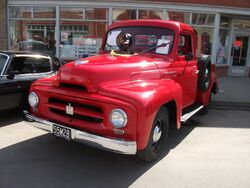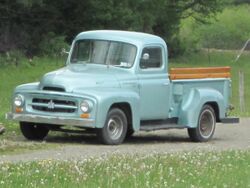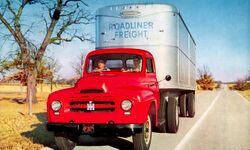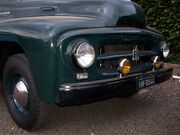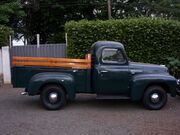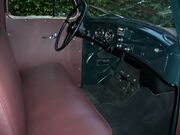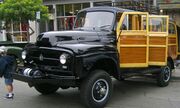Engineering:International Harvester R series
The International R series was a truck manufactured by International Harvester. It replaced the L series in 1953. It was mostly a facelift of the light and medium models. The front style seen on the L series redesigned for the R line. A simple rectangular opening with a tapered bar running across the center replaced the ornate grill design of the L series, and the IH "man on a tractor" logo was placed in the center. The heavy duty models (R-185 and higher) were changed only slightly in appearance, in that four of the seven vertical bars in the upper grille were removed.
There were few mechanical changes in the R line, other than facelifts. There were twenty-nine engines available. Both Cummins and Buda Diesels were now offered in the RD-190 and RD-200 Series, whereas only Cummins had been available, and even then only in models larger than the 190/200 Series.
Gasoline engines
A new Black Diamond 282 engine became the standard powerplant for the R-180, RC-180 and RF-170 models, and was optional in the R-175 Roadliner tractor. The new engine had a shorter stroke, a chrome alloy cylinder block, and a higher lift camshaft. It also featured slow rotating Stellite-faced exhaust valves and chromed top piston rings. A new "visible flow" carburetor had a fast idle cam that speeded engine warm up.
The three sizes of Super Red Diamond engines (372, 406, and 450 cid) had improved combustion chambers, redesigned valve ports, rotating exhaust valves with more durable seats and improved rings. The Super Blue Diamond (269 cid) had a new cylinder head with improved valve ports and coolant passages, altered ignition timing for the new 6.5:1 compression ratio, aluminum-alloy pistons, and "visible flow" carburetor.
The little Silver Diamonds (220 and 240 cid) engines featured rotating valves and improved carburetor, plus a ceramic fuel filter and hotter spark plugs. LPG engines, which had previously been offered only in L-185 and larger models, were available in trucks as light as the R-150 in the new line.
New models
There were also totally new trucks available at the IHC dealers in 1953. One was the Tilto Cab R-195 and R-205 with cab-over-engine design. However, only a few units were ever built by Hendrickson. The R-195 had a 24,000 lbs GVW, used a Red Diamond 406 engine, 14-inch clutch, overdrive or direct drive (in top gear) five-speed transmission, and Eaton single reduction rear axle. The R-205 was similar, but featured the Red Diamond 450 engine, heavier transmission and axles, and larger brakes. The standard tire size for both models was 10.00x20 14 ply.
Another vehicle which was not only new to the lineup but practically a new concept was the Fageol van. Known earlier as the "Manhattan Express", it was a marriage of a semi-trailer and a truck chassis, with the driver's compartment in the front part of the trailer cavity.
4x4 models debut
All-wheel-drive trucks were offered in International's line as a factory option for the first time in 1953. Previously any such modification would have been made by third parties, or perhaps IHC's own truck modification centers at Fort Wayne, Indiana, or Springfield, Ohio. It was a small beginning: only the R-140 4x4 and the R-160 4x4 were offered initially, but there were more to come.
Pickup trucks
In the light pickup truck arena, the new R-110 pickup was a handsome little rig. The clean lines of the grille, hood and front fenders were simple, but pleasing. Exterior chrome plating was used only sparsely, on the identifying logos and on the door handles, but the design did not need chrome to look good. The 115 in wheelbase model featured a 6.5 foot pickup box, and cost $ 1,384.00.
For 1954, IHC introduced the new R-100, which looked exactly as the R-110, but cost US$ 60 less, and carried some improvements. including a bit more horsepower, improved gear ratios, larger brakes, more flexible springs. With a 4,200 lbs GVW (4,600 lbs on R-102) riding a 115 in wheelbase, the power came from a Silver Diamond 220 cid (3.6L), in-line 6-cylinder engine with overhead valves, 104 hp and a 7:1 compression ratio (up from 100 hp and 6.5:1 on the R-110), driving a 3-speed transmission and a semi-floating rear axle. By mid '54 it could also be had with an overdrive transmission which provided a 30% reduction in engine speed at 60 miles per hour, or with a torque converter fully automatic transmission (basically a GM sourced 3-speed Hydramatic). Power steering also became an option. Tire size was 6.00x16 6 ply.
Production output
Production figures for 1953 were 123,026 (77,817 trucks built at Springfield, 38,613 at Fort Wayne, 626 at Emeryville and 5,970 at Bridgeport), plus another 13,912 trucks built and Chatham, Canada, for a grand total of 136,938.
In 1954 the production totalled 105,463 units (Fort Wayne built 33,637, Emeryville handled 680, Bridgeport produced 7,041, while Canadian Chatham plant churned out 7,073 units).
The biggest seller during the 1954-55 period was the R-110 model, with 72,659 built.
Epilogue
Although it had been only two years since the L line had been revised to become the R line, 1955 was to be another year of big changes for light and medium series. In September the new S series was announced, replacing the R models from the 100 to 180 series. The heavier-duty versions continued to be in the R series, until this line was finally replaced in 1972.
See also
- List of International Harvester vehicles
References
- Crismon, F W (1995). "International Trucks", p. 246-262, 'Motorbooks International Publishers and Wholesalers'.
Further reading
- Foster, Patrick (2015). International Harvester Trucks, The Complete History. Motorbooks. ISBN 978-0-7603-4860-4. https://www.amazon.com/International-Harvester-Trucks-Complete-History/dp/076034860X.
External links
- International Harvester R (Internet Movie Cars Database)
- Marque website
- Standard R-110, R-111, R 112 (1953). Wisconsin Historical Society. 2011. http://content.wisconsinhistory.org/cdm/compoundobject/collection/ihc/id/36853/rec/14.
